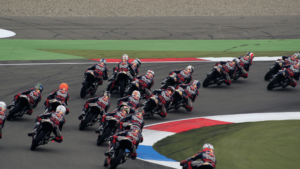
How manufacturers use racing to sell bikes - and how effective is it?
For several decades, motorcycle manufacturers have used the adrenaline and glamour of elite level racing to increase their visibility and boost sales. The philosophy of ‘win on Sunday, sell on Monday’ has been ingrained in the industry for many years, emphasising the concept that success on the race track translates to commercial success in the showroom. It sounds obvious, that the exhilaration of watching the best riders in the world do battle on the best bikes would surely help sell lots of motorcycles. But how true is that?
Our latest Motorcycle Marketing blog will therefore explore the effective use of racing as a marketing tool by motorcycle manufacturers, delving into its origins, the types of motorcycles promoted in various championships, the pros and cons of this tactic, and how the landscape of motorcycle marketing has evolved.
Origins of racing and manufacturer participation
Motorcycle racing has a rich history, with events like the Dutch TT, the Isle of Man TT, and Grand Prix racing serving as breeding grounds for manufacturers to showcase their engineering prowess and performance capabilities.
The FIM World Championship Grand Prix - which is now simply known as MotoGP – dates back to 1949 as a formalised championship. Big international race meetings, some of which eventually became part of Grand Prix racing, date back much further, to the start of the twentieth century.
Brands such as Norton and MV Agusta achieved great success in the early days of racing, before the big Japanese brands came along to start dominating from the late 1960s through to the 2000s.
There are many different types of World Championship racing under the umbrella of the Fédération Internationale de Motocyclisme (FIM).
In MotoGP manufacturers showcase prototype motorcycles - bikes that are built for racing only and not available for sale - and cutting-edge technology, pushing the boundaries of speed, handling and innovation.
Meanwhile in championships such as WorldSBK, MotoAmerica and British Superbikes (BSB), you will see high performance sports bikes on track. These are production motorcycles that have been fine tuned for racing with the highest-grade components.
On the 2023 WorldSBK grid for example, you’ll see the Ducati Panigale V4R, Yamaha YZF R1, Kawasaki ZX-10RR, Honda CBR1000 RR-R and the BMW M 1000 RR.
In the MXGP and AMA Supercross Championships, the manufacturers display their finest motocross bikes, showcasing their durability and versatility. There’s more off-road technology at the sharp end of the competition in the Dakar and the World Rally Raid Championships (W2RC) with rally-prepared versions of dual-sport bikes prepared by the factories to deal with grueling conditions, highlighting their endurance and rugged capabilities.
In the new FIM E-Xplorer World Cup the participating manufacturers Cake, EM, EMX Powertrain and SUR RON compete with electric off-road motorcycles, demonstrating their potential for sustainable racing.
The effectiveness of racing as a sales tactic
The tactic of using racing to drive bike sales comes with its own set of pros and cons. On the positive side, racing enhances a manufacturer's brand image, instilling a sense of excitement, performance, and reliability in the minds of consumers.
Success on the race track can cultivate a sense of trust and credibility, making potential buyers more inclined to choose a motorcycle from a victorious manufacturer. The exposure garnered from racing enables manufacturers to showcase their technological advancements and attract new customers.
However, this strategy is not without its challenges. Participating in elite-level racing requires substantial investment in research and development, race team infrastructure, and marketing efforts. Manufacturers must strike a balance between allocating resources to racing and other marketing channels.
Additionally, winning races does not guarantee immediate sales success, as consumers consider a range of factors such as pricing, aesthetics, and brand loyalty when making purchasing decisions.
It’s not always easy to attribute increased sales directly to the investment put into success in racing. Also, could going racing but finishing at the back of the pack even diminish your sales, even if you still get plenty of brand exposure?
The changing landscape of motorcycle marketing
While racing remains a powerful tool, the effectiveness of this traditional marketing tactic has evolved. Manufacturers can now directly engage with their target audience, create buzz, and showcase their products through digital platforms, social media engagement and influencer marketing. Achieving commercial growth away from racing has become more feasible, completely challenging the notion that motorsports are the sole key to market dominance.
PR, advertising, content marketing, track days, trade events and the festival scene provide alternative avenues for motorcycle manufacturers to gain visibility, credibility and generate sales.
Some manufacturers are 'all in' on racing
Several manufacturers have wholeheartedly embraced racing as a core element of their marketing strategy. Honda, with its long-standing commitment to MotoGP, showcases its engineering prowess and technical expertise through racing success, even if they have struggled to maintain their status as the top dogs in the premier class in recent times. Ducati, in particular, have pushed harder and harder towards the top and are now considered to have the best bike in MotoGP and WorldSBK.
KTM's success over the last decade in the MXGP and AMA Supercross Championships, coupled with their progress in MotoGP to become race winners, exemplifies their dedication to racing as a means of brand promotion. There’s a reason why the Austrian brand’s slogan is ‘#Ready To Race’.
For some manufacturers racing is not so relevant
On the other hand, for some of the major manufacturers, such as Royal Enfield and Harley Davidson, racing is not so relevant, given their traditional focus on models which are not used in the best-known race series.
Suzuki dropped a bombshell when they decided to leave MotoGP at the end of 2022 despite having won the World Championship with Spanish rider Joan Mir in 2020.
A Suzuki statement at the time read, “Unfortunately, the current economic situation and the need to concentrate its effort on the big changes that the Automotive world is facing in these years, are forcing Suzuki to drastically decrease racing related costs and to use all its economical and human resources in developing new technologies.”
Racing’s positive impact on sales: Ducati and KTM
Ducati's success in MotoGP and WorldSBK in recent years has solidified its reputation for producing high-performance motorcycles, attracting riders worldwide. Ducati are the current champions in both of those series and according to Statista the Italian brand have achieved solid global sales over the past decade, with worldwide unit sales expected to reach 28,140 in 2027.
Similarly, KTM's consistent success in the MXGP and AMA Supercross Championships has been impressive, as have the increases in the brand's visibility and sales. KTM's expansion into road racing, including its victories in MotoGP with Brad Binder and Miguel Oliveira on the RC16, has further enhanced the brand's reputation.
Again Statista data reflects the apparently positive correlation between KTM's racing success and its unit sales, showcasing the effectiveness of racing as a marketing tool. Revenue for KTM is projected to reach US$1.39bn in 2023, rising to US$1.76bn by 2027.
So is it worth going racing?
Racing continues to be a potent marketing tool for motorcycle manufacturers, allowing them to capture the imagination of current riders and potential customers, to build brand reputation, and ultimately drive sales. While social media and alternative marketing channels increasingly offer additional avenues for growth, racing still remains a time-tested method of showcasing a manufacturer's technical prowess.
Brands like Ducati and KTM have effectively leveraged their racing success to boost sales and establish a strong foothold in the market. However, it is undeniable that the approach to marketing has evolved, and achieving visibility and credibility away from racing is now more feasible than ever before.
As the industry continues to evolve, motorcycle manufacturers must strike a balance between traditional racing involvement and exploring new avenues for engaging with their target audience, ensuring a comprehensive and effective marketing strategy.
If you're looking for ways to benefit from your racing efforts in your online marketing activities, don't hesitate to contact us to explore the possibilities.



